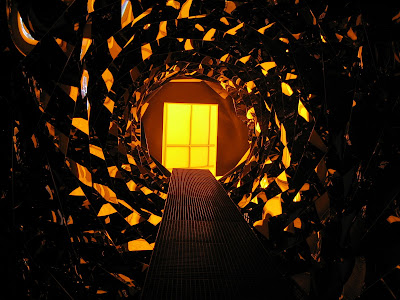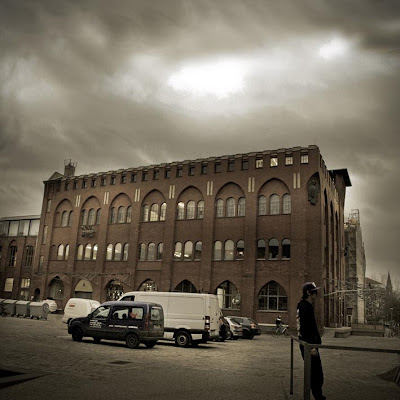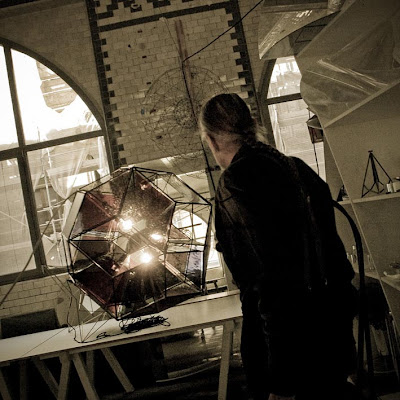Einar Thorsteinn
Art Vent Letting the Fresh Air In


 Merry Christmas! Keeping up-to-date with the geometric adventures of my friend, Einar Thorsteinn, who lives in Berlin, this is his latest creation: a configuration he defined in 1978 but has just now built. He gave me an explanation about expanding on the transformation in geometry Buckminster Fuller called "Jitterbug" (sometimes when Einar tries to explain things to me it makes my brain hurt), but I just think it’s beautiful—as did Olafur Eliasson, who will be showing a work based on it at a Madrid gallery in January.
Merry Christmas! Keeping up-to-date with the geometric adventures of my friend, Einar Thorsteinn, who lives in Berlin, this is his latest creation: a configuration he defined in 1978 but has just now built. He gave me an explanation about expanding on the transformation in geometry Buckminster Fuller called "Jitterbug" (sometimes when Einar tries to explain things to me it makes my brain hurt), but I just think it’s beautiful—as did Olafur Eliasson, who will be showing a work based on it at a Madrid gallery in January.Which comes first, the artist or the landscape? I remember being profoundly disappointed when I went to Aix-en-Provence and discovered that the countryside looked exactly like a Cezanne. Damn! He just painted what was in front of him--although he did elaborate a bit on Mount St. Victoire, which was punier than I expected. And Venice looks just like Canaletto, Paris like that rainy day Caillebotte at the Art Institute in Chicago I've always loved, and while I haven't been to China, a friend told me that the mountains and mist look just like--Chinese paintings. So now that I live on the edge of the Hudson River Valley I think a lot about the painters of the Hudson River School and how they, too, were painting just what was in front of them. Or were they? Perhaps I see it the way I see it because I've been shown it through their eyes.
I thought about this a lot on our trip to
I get annoyed when people apologize for photographs, but this is the best I have of the cliff line with waterfalls at Þingvellir, taken around 11:00 at night with an overcast sky. At least you get the idea. I haven't yet got the hang of taking photographs in Iceland, but it's something I look forward to working on.
Readers of this blog know how passionate I am about keeping the art experience free from any interference that attempts to interpret the work for viewers or bombard them with information that gives the impression that art is about, well, information. This is a philosophy I share with Robert Irwin and Olafur, who was greatly influenced by Irwin (did I get the idea from them or was I attracted to them because of it?—another question that can never be answered). No wonder I’m so comfortable in
The only sign I saw at Gulfoss, one of the biggest waterfalls in Iceland. The cloverleaf symbol indicates an official site of natural or historic interest.
And now I’m off to
 I am proud of my garden but all I did was put in some seeds and keep the weeds out. I find it difficult to take credit for nature.
I am proud of my garden but all I did was put in some seeds and keep the weeds out. I find it difficult to take credit for nature.
I thought Art Chicago was pretty boring—only a handful of really good galleries represented—but, to my surprise, loved the Antiques Fair a few floors below. Meanwhile the Olafur Eliasson exhibition at the MCA (through September 13th) has caused a lot of excitement—as I mentioned, so much better than at MoMA and PS 1—and the the pairing with the Buckminster Fuller show (through August 9th) is genius, because you can see the lineage. As I’ve no doubt mentioned before, Einar Thorsteinn, who works with Olafur (“helps me with models and helps me to think,” as Olafur said in his artist’s talk), was a protégé of Fuller, and so here you can look at Fuller’s models and then go downstairs and see how Olafur and Einar have taken off on them in their own models, made them more fanciful, and then elaborated on them in large works. There are also interpretations of Fuller’s work by sculptor Kenneth Snelson, which are gorgeous. I wish I had images to illustrate all of this, but I was only able to photograph Eliasson’s exhibition while accompanied by a representative of the MCA, and had not made an appointment to shoot the Fuller show.
Let me go off a little bit on this policy of no photography, which is shared by the Whitney (but not by MoMA), and the reason I didn’t write about Jenny Holzer’s show here, which I loved. Yes, I could have gotten images from the museum, but if they didn’t reflect my vision, I’d just be doing P.R. I could understand it in the old days, the concern that a lousy shot taken on someone’s Brownie could end up in a magazine as representative of the artist’s work, or that people would produce coffee mugs and T-shirts with a pirated image. But today, when the influence of print is lessening and word-of-mouth rules, why would you want to insist on stopping someone from taking a picture with her iPhone and emailing her excitement to all of her friends? As for artists, photography is a way of recording what is important to them—not some commercial photographer—ideas that they may want to incorporate into their own work. As we all know, major museum exhibitions have an influence on the art that comes after, and to limit that in any way seems counter-productive.
 Museums seem to be catering more and more to the casual visitor while distancing themselves from artists. First there’s the entrance fee, which limits when you can see the work (in crowds on free night). I tried to get a friend who’s a professor of art in Iowa into MoMA on my press card with me, and was told she could come in for free if she had a group of students with her. But even if she were teaching in New York, doesn’t she have to see the show first, to decide if it’s something she wants to bring her students to? I know so many artists who choose to pass on major exhibitions because of the fee, and often if you find a good show, you want to see it more than once. In Chicago, no doubt, many artists can afford to join both the MCA and the Art Institute (or “INSTITVTE” as it reads on their Web site—yikes!), but in New York, with a plethora of major museums, cost becomes prohibitive. I propose that the New York museums get together on an “artist’s card” that would allow entrance to all the museums for a yearly fee of $125 or so. Verifying that someone is an artist is easier now than it was back in the day when I had to prove my professional status to the city in order to live in SoHo—it can be anyone who has a Web site featuring their work, or is featured on a gallery Web site. Such a policy would increase not only traffic but word-of-mouth.
Museums seem to be catering more and more to the casual visitor while distancing themselves from artists. First there’s the entrance fee, which limits when you can see the work (in crowds on free night). I tried to get a friend who’s a professor of art in Iowa into MoMA on my press card with me, and was told she could come in for free if she had a group of students with her. But even if she were teaching in New York, doesn’t she have to see the show first, to decide if it’s something she wants to bring her students to? I know so many artists who choose to pass on major exhibitions because of the fee, and often if you find a good show, you want to see it more than once. In Chicago, no doubt, many artists can afford to join both the MCA and the Art Institute (or “INSTITVTE” as it reads on their Web site—yikes!), but in New York, with a plethora of major museums, cost becomes prohibitive. I propose that the New York museums get together on an “artist’s card” that would allow entrance to all the museums for a yearly fee of $125 or so. Verifying that someone is an artist is easier now than it was back in the day when I had to prove my professional status to the city in order to live in SoHo—it can be anyone who has a Web site featuring their work, or is featured on a gallery Web site. Such a policy would increase not only traffic but word-of-mouth.That said, here are some random shots from the Eliasson exhibition:

 Your eye activity field, 2009, oil on canvas (detail). Created for the MCA's lobby and atrium, this series of 300 canvases (approximately 6" x 14") represents the 300 nanometers of the color spectrum that can be seen by the human eye
Your eye activity field, 2009, oil on canvas (detail). Created for the MCA's lobby and atrium, this series of 300 canvases (approximately 6" x 14") represents the 300 nanometers of the color spectrum that can be seen by the human eye Reimagine, 2002: spotlights cast shiftin, overlapping rectalinear patters across the gallery wall, creating an illusion of distance and depth.
Reimagine, 2002: spotlights cast shiftin, overlapping rectalinear patters across the gallery wall, creating an illusion of distance and depth. Beauty, 1993: a spotlight shining obliquely through a curtain of fine mist.
Beauty, 1993: a spotlight shining obliquely through a curtain of fine mist. From the model room
From the model room
 One-way colour tunnel (detail) with view of Inverted Berlin sphere, 2005
One-way colour tunnel (detail) with view of Inverted Berlin sphere, 2005
 Colour sphere embracer, 2005, colored glass rings suspended from the ceiling nestle inside one another while a motor simultaneously rotates each in a different direction.
Colour sphere embracer, 2005, colored glass rings suspended from the ceiling nestle inside one another while a motor simultaneously rotates each in a different direction.When Buckminster Fuller visited Reykjavik two years later, Einar told him this story. “I’m happy to know this,” Bucky said, “because I like to think that everyone has some good in them and I’ve never heard anything positive about Nixon.”
Einar writes about this, his first visit with Fuller, in his upcoming book about his 40-year quest to find what he has named the “Fang,” which is, in geometric terms “a space-filler for five-fold symmetry space.” Below, Einar’s geometry at work in one of Olafur Eliasson’s installations, Your spiral view (2002), which I photographed at the Kunstmuseum in Wolfsburg, Germany, in 2004, and is now part of the Beyeler Foundation collection.

Statesmanship is an art, which means that there is always room for inspiration, and for grace. We are right to look for a record of pre-eminent ability when we can find it. But the basic doctrine of republican government, that all men are created equal, can be a surprise bonus for some leaders, as well as a guarantee of rights for all of us. Sometimes greatness appears in unlikely places, even in ordinary pols from Illinois.
Einar's studio:




 The office:
The office:
The living room:

The dining area:

Einar at work:









